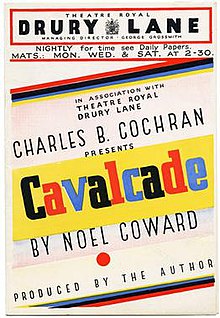Cavalcade (musical)
| Cavalcade | |
|---|---|

Promotional flyer
|
|
| Written by | Noël Coward |
| Characters |
|
| Date premiered | 13 October 1931 |
| Place premiered |
Theatre Royal, Drury Lane London, England |
| Original language | English |
| Subject | Death, War, Titanic, Great Depression, Romance, 20th century |
| Genre | Drama |
| Setting | Upstairs and downstairs of the Marryot's house |
Cavalcade is a play by Noël Coward with songs by Coward and others. It focuses on three decades in the life of the Marryots, a quintessential British family, and their servants, beginning in 1900 and ends on New Year's Eve in 1929 and is set against major historical events of the period, including the Relief of Mafeking; the death of Queen Victoria; the sinking of the Titanic; and World War I. The popular songs at the time of each event were interwoven into the score.
The play was premièred in London in 1931 at the large Theatre Royal, Drury Lane. The spectacular production produced by Charles B. Cochran involved a huge cast and massive sets. The play was very successful and ran for almost a year. It took advantage of the large stage of the Drury Lane Theatre with its hydraulics and moving components to dramatise the events. The film adaptation in 1933 won an Academy Award for best picture, and the 1970s Television series Upstairs, Downstairs was based on the play.
Coward began researching the project while appearing in the Broadway production of Private Lives, finding inspiration in back issues of The Illustrated London News he had brought to New York City with him expressly for that purpose. He also drew on his personal memories for many of the twenty-two scenes in the three-act play.
After returning to London, Coward continued to work on the play. Knowing the size and scope of the project would require as large a venue as possible, he and designer Gladys Calthrop inspected Theatre Royal, Drury Lane and found it to be ideal due to the depth of the stage, the width and height of the proscenium, the various lighting and flying effects that could be achieved, and the six hydraulic lifts that could be utilized to move scenery easily. While Calthrop began the task of designing hundreds of costumes and dozens of sets, Coward worked on the script, which he completed in August 1931. Rehearsals began the following month.
...
Wikipedia
